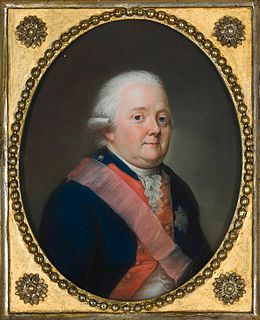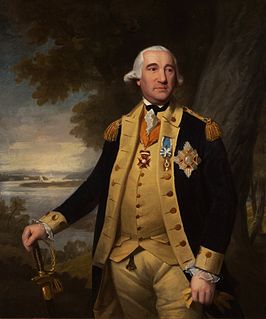
Freiherr Friedrich Adolf Riedesel Freiherr zu Eisenbach was a German officer who served in the Seven Years' War and American War of Independence. He was the commander of the Braunschweiger Jäger, a regiment of soldiers from the Principality of Brunswick-Wolfenbüttel that was among the German units hired by the British during the American War of Independence. He then commanded all German soldiers in the Saratoga Campaign.

Hessians were German soldiers who served as auxiliaries to the British Army during the American Revolutionary War. The term is an American synecdoche for all Germans who fought on the British side, since 65% came from the German states of Hesse-Kassel and Hesse-Hanau. Known for their discipline and martial prowess, around 30,000 Germans fought for the British during war, comprising a quarter of British land forces.

Count Carl Emil Ulrich von Donop was a Hessian colonel who fought in the American Revolutionary War. He died of wounds during the Battle of Red Bank.

Wilhelm Reichsfreiherr von Innhausen und Knyphausen was a German general officer who served in Hesse-Kassel. He fought in the American Revolutionary War, during which he commanded Hessian auxiliaries on behalf of Great Britain.

Louis I, Grand Duke of Hesse was Landgrave of Hesse-Darmstadt and later the first Grand Duke of Hesse and by Rhine.
Hesse-Hanau was a territory in the Holy Roman Empire. It emerged when the former county of Hanau-Münzenberg became a secundogeniture of Hesse-Cassel in 1760. When the reigning count, William IX, also became landgrave of Hesse-Cassel in 1785, the two governments began to merge, although the process was delayed first by French occupation, and later by incorporation into the French satellite duchy of Frankfurt. The incorporation of Hesse-Hanau with Hesse-Cassel was not completed until 1821.
The Northern theater of the American Revolutionary War also known as the Northern Department of the Continental Army was a theater of operations during the American Revolutionary War.

Ethnic Germans served on both sides of the American Revolutionary War. Large numbers of Germans had emigrated to Pennsylvania, New York and other American colonies, and they were generally neutral or supported the Patriot cause. Many belonged to pacifist sects such as the Amish. Britain had a small army, most of which were needed at home. It decided to rent regiments. Most governments refused, but several small German states such as Hesse had a reputation as "mercenary states" and rented regiments to the British for combat duty. The Patriots called them all "Hessians" and denounced them all as "mercenaries" who were not fighting for their native land. In his history of the Hessians, Rodney Atwood says, "By common usage, however, the Hessians have been called mercenaries. In this work I refer to them as both auxiliaries and mercenaries."

The Battle of Trenton was fought on December 26, 1776, during the American Revolutionary War campaign for New Jersey. In a surprise attack, the Continental Army led by George Washington attacked the winter quarters of a brigade composed primarily of German troops from Hesse-Kassel in Trenton, New Jersey. The Hessian brigade was under the command of Colonel Johann Rall; he died of wounds sustained in the battle, and about two thirds of his men were taken prisoner. It was the first major victory after a long string of defeats that had resulted in the loss of New York City, and was a significant boost to American morale. It was followed by two more American victories, first in a second battle at Trenton on January 2, 1777, and then on January 3 at Princeton.

Leopold Philip de Heister was a Hessian general who fought for the British during the American Revolution.

Johann Reinhard III of Hanau-Lichtenberg was the last of the counts of Hanau-Lichtenberg. He reigned from 1680 to 1736. From 1712 to 1736, he also reigned the County of Hanau-Münzenberg.
Georg Pausch was a soldier from Hesse-Hanau. He is noted for the journal he left describing the experiences and those of his company in Canada with Burgoyne's campaign. The campaign culminated in Burgoyne's surrender after the Battle of Saratoga.

Friedrich Casimir of Hanau was a member of the Hanau-Lichtenberg branch of the House of Hanau.

The Electorate of Hesse, also known as Hesse-Kassel or Kurhessen, was a landgraviate whose prince was given the right to elect the Emperor by Napoleon. When the Holy Roman Empire was abolished in 1806, its prince, William I, chose to retain the title of Elector, even though there was no longer an Emperor to elect. In 1807, with the Treaties of Tilsit, the area was annexed to the Kingdom of Westphalia, but in 1814, the Congress of Vienna restored the electorate.
The County of Hanau-Münzenberg was a territory within the Holy Roman Empire. It emerged when the County of Hanau was divided in 1458, the other part being the county of Hanau-Lichtenberg. Due to common heirs, both counties were merged from 1642 to 1685 and from 1712 to 1736. In 1736 the last member of the House of Hanau died and the Landgrave of Hessen-Kassel inherited the county.
The Hessian War, in its wider sense sometimes also called the Hessian Wars (Hessenkriege), was a drawn out conflict that took place between 1567 and 1648, sometimes pursued through diplomatic means, sometimes by military force, between branches of the princely House of Hesse, particularly between the Landgraviate of Hesse-Cassel and the Landgraviate of Hesse-Darmstadt. It was triggered by a division of inheritance following the death of the last landgrave of all Hesse, Philip I in 1567.
Creuzbourg's Jäger Corps(Jäger-Corps von Creuzbourg) was an independent Jäger battalion raised by the county of Hesse-Hanau and put to the disposition of the British Crown, as part of the German Allied contingent during the American Revolutionary War. The corps fought at the Battle of Oriskany, although mostly serving as garrison of different Canadian posts.

Brunswick Troops in the American Revolutionary War served as auxiliaries to the British Army during the American Revolutionary War, in accordance with the treaty of 1776 between Great Britain and the Principality of Brunswick-Wolfenbüttel. Four regiments of foot, one regiment of dragoons, one grenadier battalion, and one light battalion with a Jäger company were dispatched to British America. Most of the Brunswick troops fought at the Battles of Saratoga, where they were forced to surrender as part of British General John Burgoyne's army. A total of 5,723 soldiers were sent overseas, and 2,708 returned to Brunswick-Wolfenbüttel. Part of the difference can be attributed to casualties, but the rest chose to remain in the United States or Canada instead of returning to Europe. Over the course of the war, the British government paid the Prince of Brunswick-Wolfenbüttel a total of £750,000 for the use of his army.

Friedrich Wilhelm von Lossberg was a Hessian Lieutenant General fighting with the British-allied German contingents in the American Revolutionary War. He was sent to America in 1776 as a colonel commanding the First Brigade of the Second Hessian Division under Lieutenant General Wilhelm von Knyphausen. Von Knyphausen in turn was second in command under General Leopold Philip de Heister.

Hesse-Hanau Regiment Erbprinz(Infanterie-Regiment „Erbprinz“ ) was an infantry regiments raised by Hesse-Hanau and put to the disposition of the British Crown, as part of the German Allied contingent during the American Revolutionary War. It was organized in one grenadier and five regimental companies and was commanded by Colonel Wilhelm Rudolf von Gall. The regiment participated in the siege of Ticonderoga 1777, the battle of Freeman's Farm 1777 and the battle of Bemis Heights 1777. It surrendered at Saratoga with the rest of the troops under Burgoyne.














